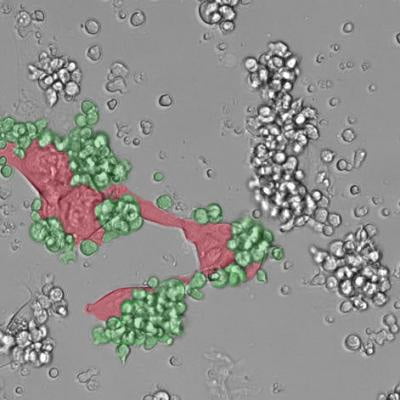Reprogramming corrupted immune cells to attack tumours
Posted: 13 June 2016 | Victoria White, Digital Content Producer | No comments yet
Researchers at EPFL have found a way to reclaim the corrupted immune cells, turn them into signals for the immune system to attack the tumour…


A microscope photograph showing immune cells (green) attacking tumour cells (red). CREDIT: Michele De Palma/EPFL
One of the major obstacles with treating cancer is that tumours can conscript the body’s immune cells and make them work for them.
Now researchers at Ecole Polytechnique Fédérale de Lausanne (EPFL) have found a way to reclaim the corrupted immune cells, turn them into signals for the immune system to attack the tumour.
Macrophages are cells of the immune system that protect the host from invading pathogens. But in cancer, macrophages can be hijacked by tumours and made to support their malignant growth and spread. EPFL scientists have now identified a molecular switch that can convert the hijacked macrophages into cells that can stimulate the immune system to fight the growth and spread of cancer.
Along with attacking foreign pathogens like bacteria, macrophages also help the body’s organs develop and its wounds heal. Their own behaviour is fine-tuned by microRNAs.
When a tumour begins to develop, macrophages attempt to block its growth. But often tumours hijack them and convert them into what are known as “tumour-associated macrophages”, or TAMs for short.
Now corrupted, TAMs use their microRNAs to shield the tumour from the patient’s immune system. This phenomenon is common across many tumour types. It is one of the major obstacles in treating cancer, and often leads to a poor prognosis for the patient.
Reclaiming TAMs
Michele De Palma’s team at EPFL found how to reclaim TAMs. The researchers genetically modified TAMs to remove their ability to produce microRNAs. As a result, the TAMs were reprogrammed dramatically. Instead of protecting the tumour, the TAMs now signalled the presence of the tumour to the immune system, triggering attacks against it – and did so very efficiently.
Using a bioinformatics approach, the researchers found that the most likely culprit was a small family of microRNAs, called Let-7. This offers a more specific target: blocking Let-7 microRNAs may help instruct the TAMs to stimulate anti-tumour immunity.
Interestingly, the researchers observed that reprogramming TAMs also stops cancer cells from leaving the primary tumour. This could mean that the approach can also prevent tumour metastasis, the most threatening aspect of cancer. Moreover, the researchers found that the re-educated TAMs could enhance the anti-tumoural efficacy of certain cancer immunotherapies, some of which are already approved for patients.
More work is needed to translate all these findings to actual therapies, especially since there is currently no way to block the Let-7 microRNAs selectively in TAMs. But De Palma’s lab is now working with bioengineers at EPFL to design drugs that can target the Let-7 microRNAs specifically in the TAMs.
Related topics
Oncology
Related organisations
Ecole Polytechnique Fédérale De Lausanne (EPFL)


